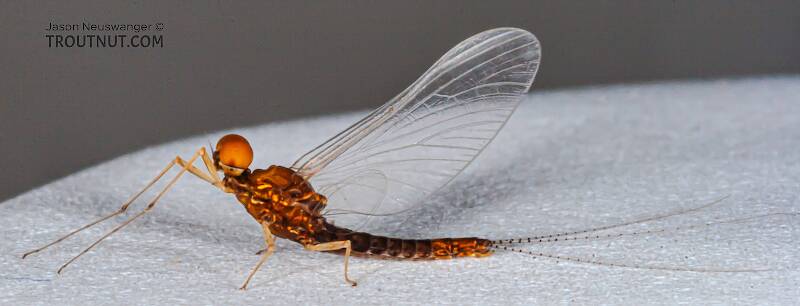
Blue-winged Olives
Baetis
Tiny Baetis mayflies are perhaps the most commonly encountered and imitated by anglers on all American trout streams due to their great abundance, widespread distribution, and trout-friendly emergence habits.


Mayfly Species Eurylophella minimella (Chocolate Duns)
Where & when
In 3 records from GBIF, adults of this species have been collected during July (33%), May (33%), and June (33%).
Species Range
Physical description
Most physical descriptions on Troutnut are direct or slightly edited quotes from the original scientific sources describing or updating the species, although there may be errors in copying them to this website. Such descriptions aren't always definitive, because species often turn out to be more variable than the original describers observed. In some cases, only a single specimen was described! However, they are useful starting points.
Male Spinner
Wing length: 6 mm
A member of the bicolor group (now a synonym of Eurylophella bicolor), rather close to E. bicolor (now a synonym of Eurylophella bicolor). Thorax and abdomen of imago darker brown than bicolor, the legs brighter yellow, and with a distinct brown spot apically on each femur.
Eyes orange. Head yellow with brown shading at the bases of the ocelli. Thoracic notum very dark brown, with yellow shading laterally and in the sutures. Sternum rather bright brown. Legs quite bright yellow; coxa tinged with brown, and with a black spot; near the apex of each femur is a distinct brown spot. Wings hyaline. Abdominal tergites 1-7 dark brown, 8-10 with paler shading; tergites 1-4 tinged slightly with smoky sub-dorsally. A narrow brown dorsal line is present, and a pair of blackish subdorsal dots near the anterior margins, which are fainter on the posterior tergites. On tergites 8 and 9 the dorsal line and the subdorsal dots coalesce. Short oblique black streaks and longitudinal black lines are present at the stigmatic region. Ventrally pale brown, the last two sternites creamy. On sternites 2-7, the usual curved row of dark dots is distinct. Tails pale, joinings blackish.
Nymph
Occipital tubercles are wanting in the male nymph. Postero-lateral spines are very poorly developed on segments 2 and 3. Dorsal spines longer, thinner and more upright than in the closely related bicolor (now a synonym of Eurylophella bicolor), especially those on tergites 5-7, which are twice as long as in bicolor. The rows of spines are evenly divergent to rearward, and not suddenly widened on tergite 5. Tails not banded.
Specimens of the Mayfly Species Eurylophella minimella
2 Male Spinners
Start a Discussion of Eurylophella minimella
References
- Jacobus, L. M., Wiersema, N.A., and Webb, J.M. 2014. Identification of Far Northern and Western North American Mayfly Larvae (Insecta: Ephemeroptera), North of Mexico; Version 2. Joint Aquatic Science meeting, Portland, OR. Unpublished workshop manual. 1-176.
- Needham, James G., Jay R. Traver, and Yin-Chi Hsu. 1935. The Biology of Mayflies. Comstock Publishing Company, Inc.
Mayfly Species Eurylophella minimella (Chocolate Duns)
Species Range
Common Name
Resources
- NatureServe
- Integrated Taxonomic Information System
- Global Biodiversity Information Facility
- Described by McDunnough (1931)



